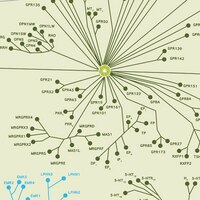GIP as a potential therapeutic agent?
Meier, J J and Nauck, M A
Horm. Metab. Res., 36: 859-66 (2004)
2004
Afficher le résumé
Glucose-dependent insulinotropic polypeptide (GIP) is released from K-cells in the gut after meal ingestion, and acts in concert with glucagon-like peptide 1 (GLP-1) to augment glucose-stimulated insulin secretion. While derivatives of GLP-1 are under active investigation for the treatment of type 2 diabetes, the case is different for GIP. Indeed, the insulinotropic effect of GIP is almost absent in patients with type 2 diabetes. In addition, the unfavourable pharmacokinetic profile of native GIP obviates its clinical application. Different analogues of GIP exhibiting prolonged stability and enhanced biological potency have been generated in order improve the anti-diabetic properties of GIP. However, glucose-normalisation, as is typically observed during the intravenous administration of GLP-1 in patients with type 2 diabetes, has not yet been achieved with GIP or its derivatives. Since GIP appears to play a role in lipid physiology and elevated levels of GIP have been associated with obesity, antagonising GIP action has been proposed as a therapeutic strategy for obesity. This concept has recently been reinforced by the observation that GIP receptor knock-out mice are protected from high-fat diet-induced obesity. However, eliminating the effect of endogenous GIP may at the same time impair postprandial insulin secretion, thereby severely disturbing glucose homeostasis. Therefore, therapeutic strategies based on either augmenting or antagonising GIP action are far from being established alternatives for the future therapy of type 2 diabetes or obesity. | 15655720
 |
GIP biology and fat metabolism.
Yip, R G and Wolfe, M M
Life Sci., 66: 91-103 (2000)
1999
Afficher le résumé
The gastrointestinal hormone, gastric inhibitory polypeptide (GIP), is synthesized and released from the duodenum and proximal jejunum postprandially. Its release depends upon several factors including meal content and pre-existing health status (ie. obesity, diabetes, age, etc.). It was initially discovered and named for its gastric acid inhibitory properties. However, its more physiologically relevant role appears to be as an insulinotropic agent with a stimulatory effect on insulin release and synthesis. Accordingly, it was later renamed glucose-dependent insulinotropic polypeptide because its action on insulin release depends upon an increase in circulating levels of glucose. GIP is considered to be one of the principle incretin factors of the enteroinsular axis. The GIP receptor is a G-protein-coupled receptor belonging to the family of secretin/VIP receptors. GIP receptor mRNA is widely distributed in peripheral organs, including the pancreas, gut, adipose tissue, heart, adrenal cortex, and brain, suggesting it may have other functions in addition to the ones mentioned above. An overactive enteroinsular axis has been suggested to play a role in the pathogenesis of diabetes and obesity. In addition to stimulating insulin release, GIP has been shown to amplify the effect of insulin on target tissues. In adipose tissue, GIP has been reported to (1) stimulate fatty acid synthesis, (2) enhance insulin-stimulated incorporation of fatty acids into triglycerides, (3) increase insulin receptor affinity, and (4) increase sensitivity of insulin-stimulated glucose transport. In addition, although controversial, lipolytic properties of GIP have been proposed. The mechanism of action of GIP-induced effects on adipocytes is unknown, and it is unclear whether these effects of GIP on adipocytes are direct or indirect. However, there is now evidence that GIP receptors are expressed on adipocytes and that these receptors respond to GIP stimulation. Given the location of its release and the timing of its release, GIP is an ideal anabolic agent and expanding our understanding of its physiology will be needed to determine its exact role in the etiology of diabetes mellitus and obesity. | 10666005
 |












